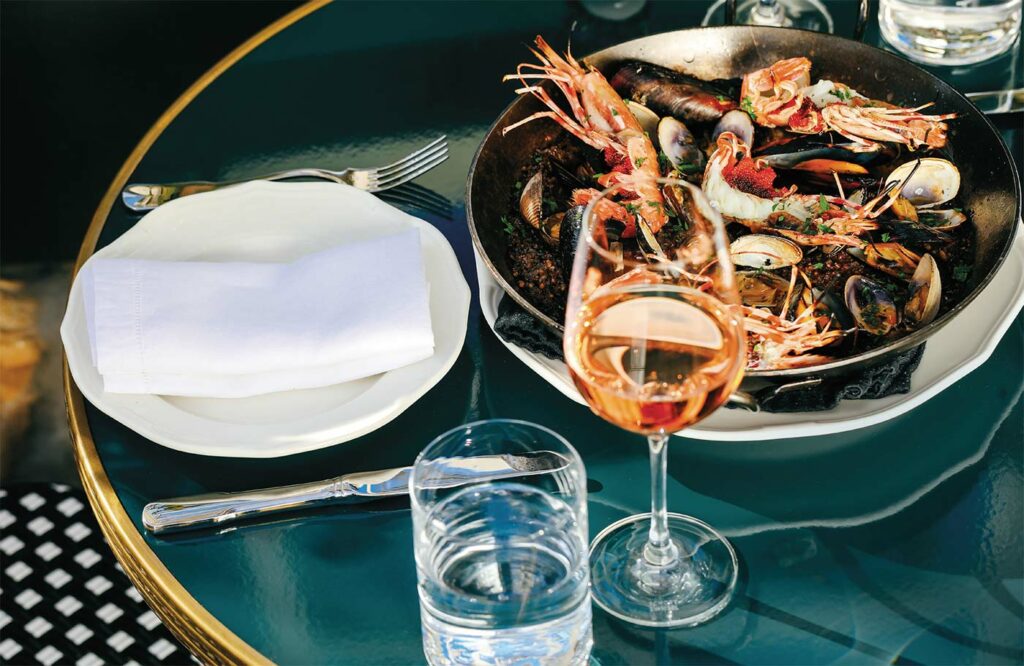
They know their stuff.”
Chez Noir’s short road and long journey to a Michelin star
PHOTOGRAPHY BY MICHELLE MAGDALENA
This summer’s Michelin star recognition for Chez Noir in Carmel, granted within 10 months of its opening in October 2022, might seem sudden.
It’s not.
And that isn’t the afterglow from a Noir dinner talking. Full disclosure, however: Between the house-curated caviar, the luminous windowpane oyster shell ceiling in the bar, and the sparkling cava from the Costa Brava, the glow is real.
A hint at the longer story surfaces right after the 2023 Michelin awards ceremony.
Back in Carmel, chef/co-owner Jonny Black is moving from an interview at the tufted linen corner booth to coaching a new cook in the kitchen, to a 10-inch stack of invoices that piled up as the Michelin star upped hype, reservation requests and abalone orders.
He pauses and looks around the space.
“A lot had to happen,” he says. “For this to happen.”

KANSAS CITY, MISSOURI • JUNE 2003
A teenager without a tribe stands at a professional demonstration kitchen on the floor of a convention center the size of 11 football fields. He’s prepared to debone a chicken and roast it while completing several sides and a dessert, from scratch.
Judges follow his every move—for eight hours—sometimes poking around his mise-en-place, wondering: How are his knife grips? How’s he handling raw chicken? Does he discard the apple core or use it for a glaze?
The national competition, now known as the SkillsUSA National Culinary Arts Competition, pits dozens of state qualifiers against each other.
The self-described loner from Virginia came to win. And Jonny Black had to win, if he wanted to finance his dream. Top finishers earn a scholarship to attend the Culinary Institute of America.
Pro chef Renny Parziale looked on. Black was ready for this, Parziale knew, because they’d been preparing for months. Still, Parziale walked away, unable to stomach the anxiety.
“It’s a lot of pressure,” Parziale remembers. “I couldn’t take it.”
He had clues the kid could.
“From the beginning, it was obvious that cooking was what he was going to do,” Parziale says. “That’s what drew chefs to go out of their way to help him.”
Parziale and Black met at a gathering of the Virginia Chefs Association, a chapter of the American Culinary Federation. Black, then 16, showed up of his own accord, knowing two things: 1) His family couldn’t afford to send him to CIA, where his favorite mentors went; 2) High school wasn’t his jam, but cooking was.
Doing the dishes at Chick-fil-A, slinging sandwiches at Subway, line cooking at The CrabCake House in Poquoson—and working in another half-dozen restaurants around Williamsburg, Va.—he took to kitchens like butter to brioche.
“I don’t know why,” he says. “I just felt more like I belonged.”
Parziale, a former culinary school instructor, knew a few things himself— ways for a student-cook to earn financial support, and how to cater a mean meal, to start.
He put Black to work in his garage, which had been converted into a commercial kitchen for Parziale’s Virginia Culinary Company. They made oils, dressings and mustards; consulted on food styling, menu development and restaurant planning; hawked kitchen gear at food shows; and catered constantly.
“We did a lot,” Parziale says.
Instead of workshopping things the efficient way, they turned tedious and tactical.
No food processors on the potatoes, zucchini and carrots. Black cleaned and tournée-cut them all himself.
No buying bones for stock. Black broke down every chicken they needed—and roasted chicken for Parziale and his young family three times a week.
“Wax on, wax off,” Parziale says. “He really excelled, and he washed a lot of dishes.”
Cue the movie montage: Black assembling crudité platter after crudité platter. Black winning his region. Black pulling chicken after chicken after chicken out of the oven. Black on stage winning state. Black hustling to load the truck for the next food event. Black in Kansas City, getting his gold medal.
With the Kansas City championship, Black won himself an education in the distinguished kitchens of CIA in Hyde Park, N.Y.
“I really loved the intensity of the competition,” Black says. “That’s probably why I love intense kitchens, and why ours is more intense than others. We’re very passionate about what we do.”
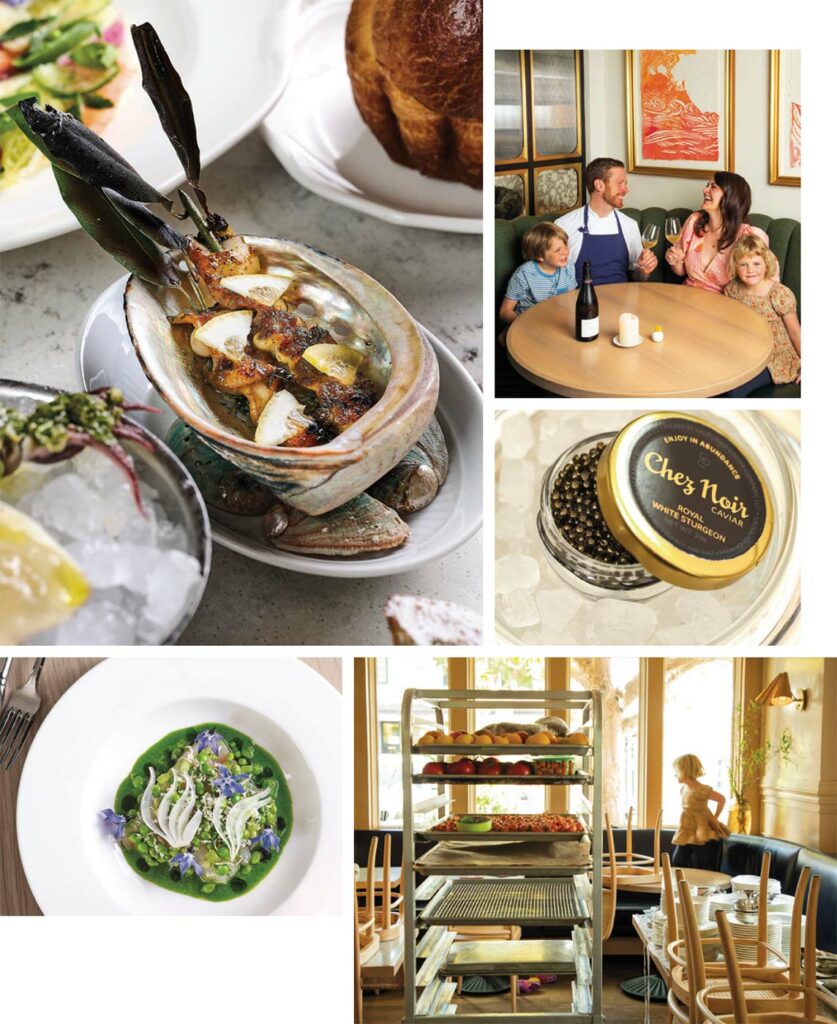
BROOKLYN, NEW YORK • OCTOBER 2012
The water inside the restaurant reaches waist height. Almost nothing—besides the custom island stove, weighing several tons—is where it was the previous day, whole appliances having drifted off.
Then a pig head floats by.
Monique Bourgea and Jonny Black, along with co-workers, stare at what’s become of the restaurant they believe in deeply.
They both work the kitchen at Governor, a new restaurant in the trendy Brooklyn waterfront district Dumbo. They have known each other for two years, but just started dating, and were miles—and years—from honeymooning in Carmel.
They met across town on the line at Colonie, a Brooklyn Heights spot known for its farm-forward menu and cocktails.
Bourgea got to Colonie first. At the time she was a line cook with a resume that included nannying, marketing internships, small scale catering and running a tiny Slavic restaurant where she was do-it-all hostess/cook/server/dishwasher/rat controller.
Her big sister, Nicole Bourgea Gleason, remembers a resolute young woman.
“There’s no telling her, ‘No,’ and she’s probably right—Mo working six jobs at once was not surprising,” Gleason says. “She is scrappy. As a kid she was always the one with the milkshake mustache and mischief in her eye.”
Meanwhile an important realization was happening: “Whenever I worked in kitchens,” Monique says, “I liked that best.”
Black arrived at Colonie not long after, a pedigreed toque from Thomas Keller’s Per Se. They both left Colonie, where Per Se alum Brad McDonald served as chef de cuisine, to help McDonald start his first restaurant.
They were all in, full send.
“I was learning so much from Brad and Jonny,” she says. “There was a level of intensity, and we were all putting our whole selves into it.”
The flood came the month after The New York Times published a review that had them vibrating with possibility.
“Governor is a serious restaurant,” it read in part, “where fresh, approachable flavors are put through some contemporary flips and twists.”
Then Hurricane Sandy surged into the Atlantic Northeast, killing 44, wreaking $70 billion plus in damages (mostly by flood) and filling Monique’s basement apartment to the ceiling.
“It brings back memories I’ve long blocked,” McDonald says. “When I left one night, I was thinking, ‘This will suck, but we have insurance.’ The next day…I knew it was done.”
A decade later, there are reasons the Blacks ended up in Carmel. Sandy ranks up there.
“It was a sign,” Jonny says.
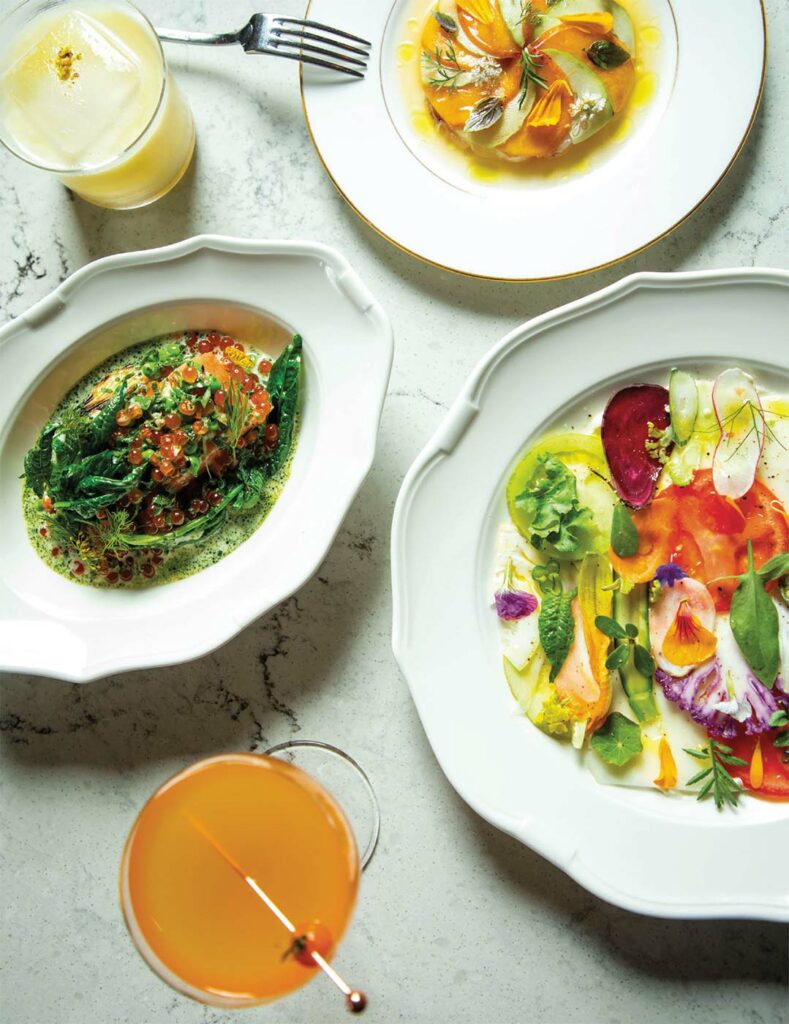
SAN FRANCISCO, CALIFORNIA • MARCH 2015
It’s so early many awake are still creaky or cranky, making final arrangements with their stalls for Saturday morning at Ferry Building Marketplace.
Chez Panisse alum Michael Tusk and Jonny Black pull up to their favorite farmers market in the city before it opens.
“Michael always wanted to be the first one at the market,” Jonny says. “He drove it into me: Have a menu that’s very much of the moment.”
Anyone worth their sea salt in California cooks seasonally, he adds. It’s another thing to be this obsessed, talking to producers, keeping a diary about annual availability, bugging growers for harvest times and buying out a farmer’s entire supply of spring asparagus or piquillo peppers.
“Stuff like that, I love it,” Jonny says. “I don’t R-and-D dishes for weeks. I like spontaneous—go to market, get the stuff, get it on the menu immediately. It’s the funnest way to cook.”
It was two months after Hurricane Sandy when Jonny headed west—asking Monique to join—for a talk and tasting with Michael and his wife Lindsay. The Tusks run Quince, a Michelin three-star, and its casual neighbor Cotogna.
The couples harmonized on many notes, team building and service among them. But nothing like that hunger for ingredients.
“Going to the market always renewed me,” Jonny says. “But Michael really turned that up.”
Jonathan Rodriguez, now executive chef of Salt Wood in Marina—who worked the line with the Blacks at Colonie, Governor and several stops thereafter, including Quince—sees that at the Friday Del Monte Farmers Market.
“Jonny must have the strongest arms at the market,” Rodriguez says with a laugh. “He fills his truck with six times the crates other chefs do.”
That echoes Monique’s discovery when she started cooking—“I just loved getting the best the market has and figuring out what to do in the kitchen”—so it’s ironic Quince would pause her line cook career.
She asked to work front of house, and to start at the bottom.
“I had been thinking about switching to the front,” she says, hinting at a master plan already incubating. “I wanted to learn.”
She began as a barista, then became a food runner and was captaining table service within six months.
“I like food a lot,” she says. “But I really love people.”
The Blacks’ culinary influences run deep, adorned with Michelin stars and name-check chefs.
They include—in part—Roland Passot of La Folie; Neil Ferguson of Allen & Delancey; Paul Liebrandt at Corton; and Per Se’s David Breeden, who now runs the day-to-day at French Laundry.
And that doesn’t dip into Jonny’s apprenticeship run through London and Copenhagen.
Post Quince, he leveled up his fine French and seafood-forward game with wisdom from Dominique Crenn. At three-star Atelier Crenn, he served as her first executive chef, while overseeing Petit Crenn and Bar Crenn and visiting France with Crenn, at one point cooking at Élysée Palace for the president of France.
Another thing about Quince: It’s in the Relais & Châteaux family of restaurants. That meant a hefty discount at L’Auberge for the Blacks’ first visit to Carmel together, where they’d later honeymoon, and decide they’d like to end up.
That move was realized when the couple left San Francisco for Sierra Mar at the Post Ranch Inn, two young kids in tow.
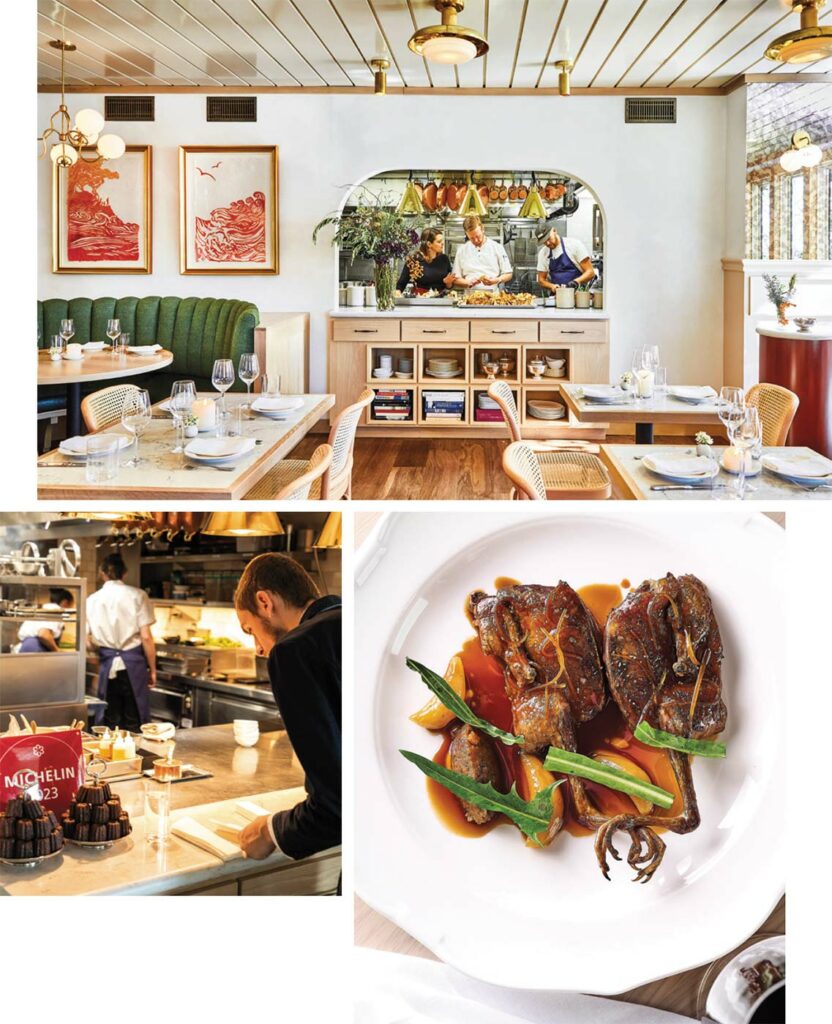
CARMEL, CALIFORNIA • MAY 1, 2023
It’s a May Monday before 5:30pm, and Chez Noir is sizzling.
Pintxos, inspired by the Blacks’ travels through Spain—think fried baby fava beans and grilled oysters with passionfruit and espelette—fly from the open kitchen.
Bigger plates from the seafood-centric menu—like the Dungeness crab tortelloni and Santa Cruz chili pepper rockfish with piperade, charred by the imported Mibrasa grill they vetted in Girona, Spain—grace the room with foodie perfume.
Rotating seasonal drinks like a snap-pea Rickey and a spring onion martini emerge from the bejeweled bar area where Ashley Havens plies fresh simplicity to create tastes that stand alone or flatter the food.
Guests feeling festive order Chez Noir’s caviar service, which typifies Jonny’s ingredient infatuation. He handpicks his preferred white sturgeon at California Caviar in Sausalito, then the eggs are smoked and seasoned with Big Sur Salt, to house specs.
Sustainability pioneer Deborah Keane, founder and CEO of California Caviar, observes a certain drive.
“He’s very hands on. He needs to know the source, touch the product, feel it, smell it, taste it,” she says. “He also has a side that’s very collaborative.”
Our two-top gets order envy watching neighboring dishes land, but the “Let Us Cook for You” prix-fixe dinner ($175 per person) means we’ll be just fine.
One of the first salvos makes the night, by itself.
The abalone skewers, grilled over coals on a bay laurel stick, laced with Meyer lemon and an abalone liver sauce that caramelizes as it cooks, merit a meditation.
Like the abalone, the signature brioche (a must-order), the squid gildas with anchovy, the whole grilled mackerel with rhubarb, and the fudge-like dates with Garden Variety sheep-milk sorbet all summon happy gasps, each dish born of few ingredients and precise handling.
I find myself taking smaller and smaller bites (and sips) of everything, trying to stretch out the experience.
Meanwhile, much else seizes the senses.
The design: antique brass lighting and vintage mirrors with fluted glass in the dining room, jade green tiled backsplash and washed white oak in the bar.
The music: A house playlist, eight hours long and crafted over months by Black as he readied for Noir’s opening, slides from French electronic pop jam “La Femme à la Peau Bleue” to Marvin Gaye’s “Make Me Wanna Holler” to Will Holland’s “Cumbia Sobre el Mar.”
Then there’s the art. Monique later points out the commissioned pieces by her sister.
The torn paper series, which moves from the dining room to the bar, unlocks scenes of the Black family looking over surging surf.
“Telling a story about being brave and diving in,” Monique says.
Later her sister relays the way Monique puts it: “It’s like, ‘Oh, my god, I’m up here riding an elephant, this is crazy.’ Then it’s, ‘Oh, my god, I’m riding an elephant! This is awesome.’”
If the art, sound and design elements didn’t dovetail so well, they’d be distracting. Still, something more abstract underlies it all—something you know when you see it, or more accurately, feel it.
It’s the stoke of the team. Committed, but not too turned up. On it, present and eager.
At the top of my menu, I scribble a word: joy. The fact that Monique and Jonny took a ton of time and thought to consider details big and small did not happen by accident.
It happened by catastrophe. Namely, COVID-19.
An awakening came first. Masterminding the food for Post Ranch Inn, a top resort in the world, can sound like a dream gig.
Only Jonny was used to small-batch operations. So he jumped to private cheffing.
Monique translates. “He was managing an aircraft carrier—which is cool—but he’s supposed to be captaining a catamaran, making changes to implement right away.”
Global shutdown was next, a surprise blessing that led the Blacks further into family days trekking forest and beach, and Jonny closer to his farmers market fever dream: shop, create, cook, repeat.
Like it did for many, COVID made them re-evaluate priorities—and provided time to deep scheme the next chapter.
Around then they met Anthony and Alissa Carnazzo from Stationaery, fellow parents of pre-schoolers, who became fast friends and role models for an existence wherein crazy restaurant demands and kids can co-exist. (At the time the Carnazzos lived above their spot off San Carlos with two kids; they now live two blocks away with three.)
“The public has a conception of people at this level of restaurant— nose in the air, not approachable—because they can provide a world-class experience,” Anthony says. “But they’re the same people they’ve always been. People are eager to be around them.”
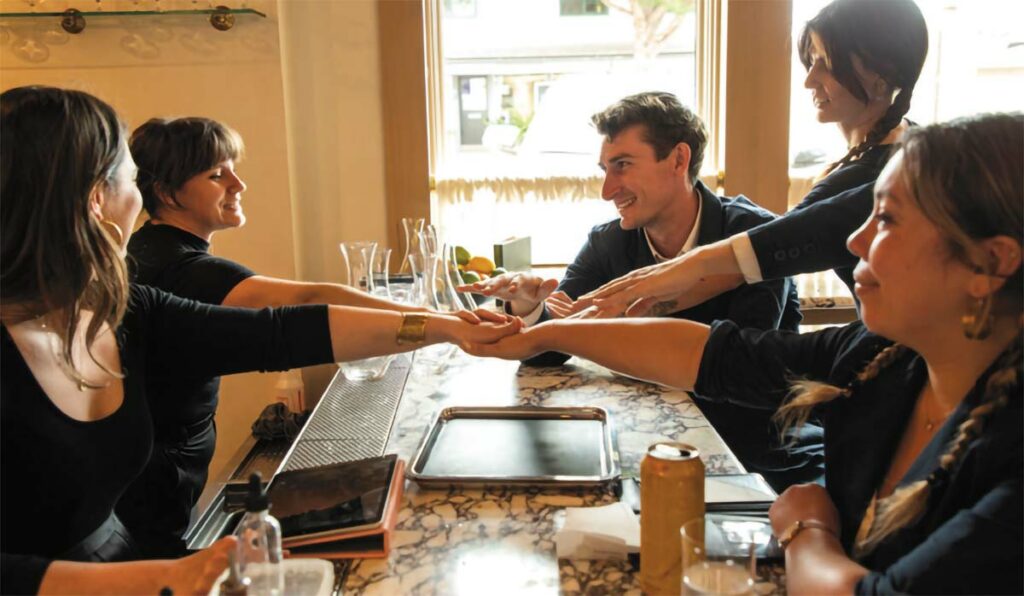
OAKLAND, CALIFORNIA • JULY 19, 2023
The stars are out, projected on the soaring dome of the Chabot Space & Science Center’s planetarium, carved into the cookies, branded on the stainless steel Yeti wine goblets.
A few hundred seasoned industry pros funnel into the steep auditorium for Michelin’s 2023 California reveal. Monique and Jonny join the queue.
“We’re just happy to be invited,” he says, perhaps relieved he doesn’t have to cook in front of judges for eight hours. “More than anything it’s great to see so many friends.”
That tracks: At the red-roped entry earlier, they can’t take a few steps without stopping to catch up with industry peers. Between the Michelin Man running around, historic satellite exhibits and Wagyu mousse with crispy seaweed from Michelin Guide-recognized Gozu, it’s a scene.
But the Blacks would rather be at a different party, and they FaceTime into that one the first chance they get.
That celebration unfolds further south, at Chez Noir. There, General Manager and Wine Director Nate Cohen pours from his small and mighty list of natural and family-owned wines that echo the Spanish-French-West Coast character of the menu and setting.
As Cohen navigates the room’s 30 guests—“I love being on the floor, this room is so conducive to a good time, the energy so palpable,” he says—he tracks the Michelin reveal as best he can.
When John Haffey of Aubergine wins Michelin’s 2023 California Sommelier Award (see story, p. 46), Cohen texts congrats. (Aubergine would also retain its Michelin star for the fifth consecutive year.)
Then the six new restaurant recipients of Michelin stars are announced, Chez Noir among them.
Cohen’s phone explodes, and he updates a Chez Noir regular seated at the corner booth for her birthday—as he promised—and she screams.
The news ripples through the tight quarters, guests start buying staff drinks, and up go glasses of Jacques Lassaigne Champagne that Cohen hand-picked for the “Let Us Pour For You” pairings ($95).
The feel of a dinner party at a pal’s house—a goal Monique broadcasts, reminding people they live upstairs—is full-bodied.
“Authentic connection is important to us,” she says. “It makes life good.”
On the second floor of the Craftsman structure, the Black kids sleep, under the watchful eye of their live-in au pair. Perhaps they’re dreaming of the next “family dinner” downstairs with the Chez Noir team, or of foraging with their folks, or traversing the Carmel Farmers Market two days later with Dad.
“Jonny and I joke we don’t have anything to offer our kids other than this,” Monique says. “This is what we do. We’re restaurant true believers. We want to share what brings people the most joy. That’s why you open a restaurant.”
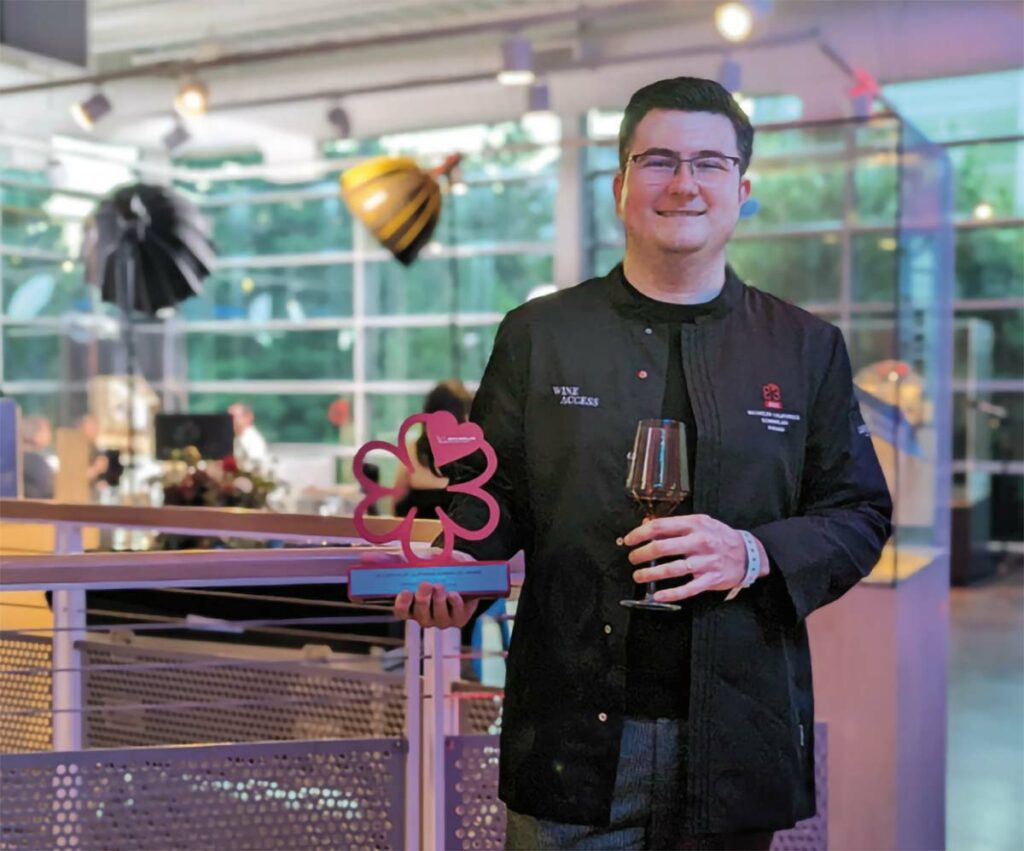
JOHN HAFFEY’S UNREAL PATH TO SOMMELIER ROYALTY
This summer’s Michelin honor for John Haffey of Aubergine might seem sudden.
It is.
He started enjoying wine seven years ago. He’s been in the industry for six. Up until 2017, he was a sales exec at Pet Food Express.
So it’s a stunning accomplishment that he became a sommelier in one of the world’s richest wine regions, at quite possibly the Monterey Bay’s best restaurant, let alone the sole wine pro among hundreds to earn Michelin’s recognition as its 2023 California Sommelier.
That speaks to a few truths.
Truth one: Haffey has the taste bud version of a photographic memory.
“For some reason, the way my mind works, I can store away the information,” he says. “Once I see the label and taste the wine, I can sort of create a file for it in my mind.”
His hard drive was booted up in 2017 by a five-hour lunch with family friends in the wine industry, wherein a vintage Mondavi was paired with rosemary roast lamb.
The synergy of vino, food, history and conversation swallowed him whole.
“This was everything I love in life encapsulated in this one thing,” he says. “That lit the fuse.”
When he saw an opening for a wine educator at Folktale Winery & Vineyards, where he was a regular, he left Pet Food Express at a trot.
David Baird, head winemaker at Folktale, recognized Haffey’s interest and started him tasting far-ranging clones and products of barrel programs.
“Let’s be clear: [Haffey] is a brilliant dude, and he has an amazing palate,” Baird says. “He was looking for his passion, and he found it. I started sharing, and he ran with it. Fast.”
Other insights emerged from blind tastings hosted by Windy Oaks wine educator Kerry Winslow.
“The first get-togethers, he was a little confused and shy, but I could tell this guy was ready to do it,” Winslow says. “He has this passion, discipline and unbelievable amount of humility, which you don’t often see in this business. He came up, in really fast time. He’s like a meteor.”
Less than a year in at Folktale, Haffey spied an Instagram post from Aubergine executive chef Justin Cogley seeking a team member. Haffey had dined there and marveled at the service.
“You don’t even notice your water has been refilled,” he says— telling his wife Montana, “My dream is to work here.”
Truth two: Haffey knew how much he had to learn, so he hustled hard as a dining room attendant, as barkeep and as substitute sommelier, tasting every bottle he could while quizzing his wine director about its backstory.
“The learning curve was intense,” he says.
Truth three: The industry and a new generation of wine professionals see a fresh era taking shape.
“Somms go against an assumption we’ll act high and mighty,” he says. “We cultivate a reality that we’re approachable and generous with information, and that—at the core of what we do—is try to make diners’ experience better, and maybe that’s just keeping your water full.”
Truth four: A little modesty goes a long way.
“At the end of the day they’re not here for me,” he says. “They’re coming to see what our chefs are doing and what ingredients they’re procuring.”
He holds the fact visitors are willing to drop $250 on his selections as a sacred challenge.
“We all work hard for our money and want it to go as far as we can,” he said after receiving the Michelin star. “We want to make sure people enjoy what they’re spending their money on.”
Alexis Carr, co-owner/operator of Santa Cruz wine bar Soif, believes Haffey’s thoughtfulness helps set him apart.
“He is constantly asking questions about the winemaking techniques involved,” she says. “I am in awe of how much knowledge he can retain about different vintages and producers. I could go on and on.”
That’s what Winslow thinks Haffey will do.
“He brings a rare level of energy and discipline,” Winslow says. “That won’t stop any time soon.”
About the author
Mark C. Anderson, EMB's managing editor and "Found Treasures" columnist, welcomes responsible and irresponsible feedback. Correspond via mark@ediblemontereybay.com.
- Mark C. Andersonhttps://www.ediblemontereybay.com/author/markcanderson/
- Mark C. Andersonhttps://www.ediblemontereybay.com/author/markcanderson/
- Mark C. Andersonhttps://www.ediblemontereybay.com/author/markcanderson/
- Mark C. Andersonhttps://www.ediblemontereybay.com/author/markcanderson/



